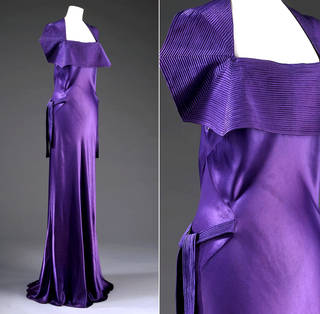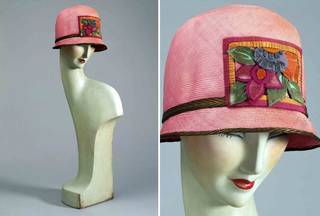Distinct, elegant and vivid in colour, items from the V&A's fashion collections reveal the relationship between Art Deco design and the clothing and jewellery of the 1920s and 1930s. From Jeanne Lanvin's haute couture to the bold geometric jewellery of Raymond Templier, Art Deco's multiple influences can be traced in their form, cut and detail.
Jeanne Lanvin's 1930s evening dresses were the epitome of Art Deco elegance, capturing a Hollywood-esque sense of glamour. Lanvin frequently combined simple, long, fluid forms with severe geometry, characteristic of the Cubism-influenced strand of Art Deco design. Her use of reflective satin echoed Art Deco's fascination with light and surface sheen.

One of the finest examples in our collection is Lanvin's bias cut evening gown in purple satin. A huge collar based on a rectangular form is made of triangles and squares. The collar is covered with narrow parallel rows of stitching that not only reinforce the fabric, allowing the collar to keep its shape, but also serve a decorative purpose. By using one strong colour, Lanvin achieved a simple, yet sculptural look.
A tennis dress, designed, made and worn by Miss Hepburne Scott, shows how Art Deco also worked its way into more functional fashion. The sleeveless, low-waisted dress, made of white linen with green linen appliqué, leans heavily on geometry, with its square neck, neat pleats and chequered pattern.

Art Deco's love of geometric form also absorbed into jewellery, replacing the intricate detailing of the past. In 1930, the Parisian jeweler, Raymond Templier (1891 – 1968), commented in the Goldsmiths' Journal, "As I walk in the streets I see ideas for jewellery everywhere, the wheels, the cars, the machinery of today". His bold, abstract designs evoked the dynamism of modern urban culture, earning him the reputation of 'architect of the jewel'.

At the end of the 1920s, an all-white look became popular. Icy combinations of diamonds, rock crystal and platinum came to the fore, with geometric, minimalist rings illustrating the severity of Art Deco design. Platinum became a favoured material, because its strength allowed minimal quantities of metal to be used, giving the stones the greatest possible prominence.

In the early 1920s, Russian artist Natalia Gonchorova worked for the Maison Myrbor, an exclusive shop owned by Italian Marie Cuttoli, selling fashion, rugs and curtains designed by the international avant-garde. Goncharova (1881 – 1962) had a long career with Sergei Diaghilev's Ballets Russes, which were a major influence on Art Deco. Goncharova produced astonishing costumes for Diaghilev, but like many Russian refugees in Paris, she also designed dresses. Her exquisite silk evening dress, with silk and velvet appliqués and metal thread, bound with lame, strongly reflects her work for the ballets and her Russian heritage.

Another striking garment, designed and made for Maison Myrbor, is a coat worn by Miss Emilie Grigsby (1876 – 1964), a wealthy independent American who came to England from New York. The wide, square coat is made from white wool embroidered with gold thread and is largely inspired by African art and Eastern cuts, illustrating the early 1920s vogue for exoticism.

The close realtionship between fashion and the wider arts can be seen in the portfolio of Sonia Delaunay. The portfolio is a facsimile of a collection of Delaunay’s watercolour designs for textiles and clothing. It includes poems and texts by various avant garde writers, which praise or relate to Delaunay's work in some way. The facsimile represents the way in which, even at the time, designers such as Delaunay were recognised in Paris for their value to the wider public. The recurrence of zig-zags and Eastern-inspired shapes are very resonant of the Art Deco aesthetic.
Art Deco's artistic sensibility can be further seen in the hand-painted plaster mannequin head, made in 1925. Its elongated features and blue-tinged skin recall the work of artists, Amedeo Modigliani (1884 – 1920) and Henri Matisse (1869 – 1954). The mannequin is typical of those displayed at the 1925 Paris Exhibition, which saw a new generation of avant garde-inspired mannequins presenting luxury fashion in exclusive boutiques.


